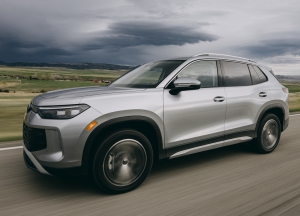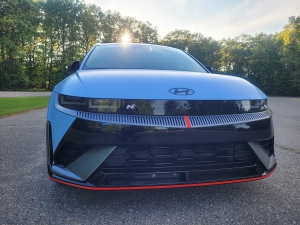
Matt M. Myftiu
Matt Myftiu has been a journalist for two decades with a focus on technology, NASCAR and autos.
2026 NASCAR Cup Series schedule: The Good and the Bad
After much anticipation and details trickling in about impending changes, the 2026 Cup series schedule is finally official.
Let’s dissect the good and the bad to come out of next year’s schedule updates.
First, here are the positive takeaways:
- GOING BACK TO CALI: Exciting addition of San Diego street race to the schedule, bringing all three of NASCAR's top series back to the important California market. It will take place at the Naval Base Coronado in San Diego, which should be an awesome backdrop. Chicago's street race had run its course, and I’m glad to see other exciting new additions to the schedule. Should be a fun weekend for fans and a popular one with drivers as well.
- AND BACK TO JOLIET: While I didn’t like Chicagoland back when NASCAR had races there years back (the final one was in 2019; all I remember from the years at the track was the giant orange bouncing down the track in qualifying). I always thought it was a bit of a bore with previous generation Cup cars. But, this Next Gen car races extremely well on the 1.5-mile tracks, so maybe it’s the right time to bring it back.
- NORTH WILKESBORO POINTS RACE: People wanted more than an All-Star race at North Wilkesboro, and they got it. I just hope it delivers and isn’t a snoozefest due to this car’s struggles on short tracks. The solid Bristol race this past weekend gives me some hope.
- EXTRA WEEK OFF: Drivers and teams will appreciate this. A second off weekend (in addition to Easter) lands in early August.
- HOMESTEAD FINALE: As we know from the many years we ended the season there, Homestead is a great finale location with tremendous racing. It’s only for 2026, as we’ll start a finale rotation for the years ahead, changing locations each year. I’m curious how the rotation goes moving forward. It’s nice to know it’s not locked in long-term at one place, as there are plenty of deserving tracks. Phoenix has run its course as the finale location and we needed a shakeup.
New 2025 Subaru Forester hybrid adds a fuel-sipping alternative to lineup
Among the Subaru lineup, the Forester SUV consistently ranks as a top seller each year — in large part due to its utility and off-road friendly design.
For 2025, something brand new has come to the Forester lineup to bring in even more interest — a hybrid offering.
This was missing in past years — as many rivals had a hybrid version to offer buyers who wanted better fuel mileage — and now will be an enticing offer to many Subaru fans who want that improved fuel economy.
Boasting higher horsepower numbers than the non-hybrid version, and roughly 40 percent better fuel economy, it should have a positive impact on the Forester’s popularity.
I recently tested a 2025 Forester hybrid (Touring trim level), and I’m back with a full report on this new offering from Subaru — which will face off against hybrid SUV offerings from Toyota, Honda, Kia, Hyundai and more.
Redesigned 2025 Volkswagen Tiguan gets impressive interior, exterior updates
Volkswagen’s lineup of SUVs are a bit unique among the competitors in the non-luxury SUV segment, as they bring a bit of European flair to battle the long list of Asian and U.S. entries in the segment.
I recently spent some time with one of these VW SUVs, the all-new 2025 Volkswagen Tiguan, which gets a full redesign for the new model year.
The Tiguan is VW’s most popular vehicle in the U.S., edging out the larger Atlas, so maintaining interest in this vehicle is critical for the brand in this country.
Both the exterior and interior have been updated, and they added new technology setups and a more powerful engine. The Tiguan now comes standard with two rows across the board and no three-row option available, as it was in 2024 and prior years.
Read on to learn more about how the Tiguan holds up against other leading compact SUVs including the Honda CR-V, Hyundai Tucson, Kia Sportage, Ford Escape, and Toyota RAV4.
NASCAR playoff predictions: Denny Hamlin will cap tumultuous year with his first Cup championship
With a flurry of debate surrounding them, the 2025 NASCAR Cup Series playoffs are upon us. Whether you like the format or not, it’s time for 16 drivers to battle for the crown, with cuts along the way to 12, 8 and 4 remaining combatants.
Even with playoff points in the mix, everything is very tight as we begin the playoffs at the Lady in Black. Co-leaders Kyle Larson and William Byron are just 26 points ahead of the cut line entering the first round — which will take place at Darlington, Gateway and Bristol. All it will take is a quick Darlington stripe to knock someone from the points lead to below the cut line.
Read on for my full playoff predictions as we enter this 10-week battle.
Round of 16: Darlington, Gateway, Bristol
The big question as we start the playoffs is whether any of the drivers below the cut line will be able to claw their way out of danger and push others into that predicament. The points are so close, that of course this can happen, even in week 1, but once the three weeks are complete, I predict that only one of the four currently below the cutline (Tyler Reddick) will survive and move on.
2025 Volkswagen Atlas Cross Sport is a sleek, stylish two-row SUV
In the competitive SUV landscape of 2025, automakers must offer a variety of choices to fit all customer needs.
So it makes sense that Volkswagen offers an alternate version of its three-row Atlas SUV, the Atlas Cross Sport, which features just two rows of seats with room for 5 passengers, and ditches the third row.
The Atlas Cross Sport, first introduced for 2020, is aimed at car buyers who want a snazzier exterior design, and don't need room for more than 5 people in their vehicle.
I recently tested a 2025 Volkswagen Atlas Cross Sport, and I’m back with a full report on how it holds up against key competitors such as the Honda Passport, Jeep Grand Cherokee and Mazda CX-70.
DQS Solutions & Staffing Acquires Majority Ownership Stake in Niece Motorsports
DEARBORN, Mich. — DQS Solutions & Staffing, recognized as one of Michigan’s fastest-growing companies and a leader in innovative workforce and operational solutions, today announced a significant national strategic investment.
CEO Josh Morris, alongside Greg Fowler, CEO of J.F. Electric, and his family, has acquired a majority ownership stake in Niece Motorsports, a prominent team in the NASCAR CRAFTSMAN Truck Series. This acquisition provides a great opportunity for DQS to build on its existing comprehensive service model, extending its influence and impact from Michigan to the national stage.
"This acquisition is far more than an investment in racing; it’s a powerful testament to our commitment to operational excellence, strategic growth, and the revitalization of key industries, particularly right here in metro Detroit," said Josh Morris, CEO of DQS Solutions & Staffing. "Niece Motorsports is a world-class organization, and we see immense potential to amplify its impact for partners, fans, and the community. This huge investment allows DQS to showcase our integrated services and solutions across the entire operational spectrum, far beyond just staffing. We're directly applying our expertise to touch all pieces of the supply chain, manufacturing, transportation, and security within the team's operations.”
2025 Volkswagen Golf GTI remains a star in the hot hatch category
The “hot hatch” category may not be the best-selling type of vehicle in this SUV world we live in, but it’s a segment where many drivers are truly invested and want to keep alive.
These sporty little cars are performance-oriented hatchbacks with fun-to-drive personalities, focused less on transporting the family and cargo space, and more on pure enjoyment of the drive itself.
One of the longtime greats in the hot hatch segment is the Golf GTI, and I recently spent some time behind the wheel of a 2025 Volkswagen Golf GTI Autobahn model. The latest version of the Golf GTI loses its manual transmission option, but still delivers a performance that driving enthusiasts will love.
Technology gets updated with mixed results, but no one can deny the driving experience in the new Golf GTI, which should continue to have its share of fans.
Read on for a full breakdown of how the 2025 Golf GTI holds up vs. other hot hatch competitors — including the Toyota GR Corolla, Honda Civic Type R, and more.
2025 Mazda CX-90 delivers looks, power and class
The top of the vehicle lineup from Mazda got a strong boost in 2024 with the outgoing three-row CX-9 model receiving a strong upgrade to the new three-row offering called the CX-90.
Beyond adding a zero to the name, the CX-90 was improved in just about every way, from looks to performance to tech — and after a strong debut, the CX-90 is back for year two in 2025, with few changes other than some trim level and feature shakeups.
I recently tested the 2025 CX-90 (a top-trim S Premium Plus trim-level model), which delivers one of the best driving experiences of any three-row SUV currently available.
Read on to learn how the CX-90 compares to three-row SUV rivals from competitors such as Kia (Telluride), Hyundai (Palisade), Honda (Pilot), Toyota (Grand Highlander), Ford (Explorer) and more.
2025 Hyundai Ioniq 5 N is a powerful, sporty electric SUV
While the regular version of the Hyundai Ioniq 5 is a solid offering, the brand was smart to realize that driving aficionados are always looking for that little bit extra, and the ultra-powerful 2025 Hyundai Ioniq 5 N was born.
New for the 2025 model year, this all-wheel-drive electric SUV from Hyundai has the numbers to challenge everything in its class, and some contenders in classes above, and is focused purely on performance.
I recently spent some time behind the wheel of an Ioniq 5 N — with its 641 horsepower and racecar-worthy setup — and I’m back with with a full report.
2025 Hyundai Kona is a small but fun compact SUV option
When it comes to SUVs, Hyundai is one brand with a stacked lineup that has all sizes covered — from those wanting a large three-row option all the way down to subcompact offerings.
One of the smaller and more affordable options from Hyundai (just one step up from the even smaller Hyundai Venue, but below the Hyundai Tucson) is the 2025 Hyundai Kona, a vehicle I recently had the chance to experience.
This funky looking but fun to drive commuter-friendly ride is among the better options for people looking for something on the smaller side, but isn’t underpowered. It received minor updates in 2025 after a fully updated version debuted in 2024.
There are plenty of rivals to consider — including the Chevy Trax and Mazda CX-30 to the Volkswagen Taos — but the Kona holds its own against them, especially on the performance end of things.
News Categories
Popular Tags
Search Reviews by Make

AutoTechReviews is your home for In-depth reviews of the latest cars, trucks, and SUVs; information on all the emerging vehicle technology; and breaking news from the world of NASCAR and other motorsports.










